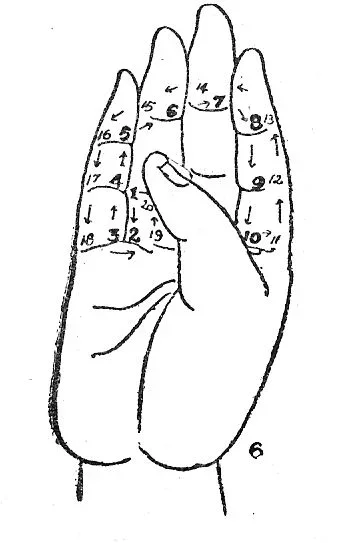pages 38-40 (concluding part)
The method of doing japam
japam is repeating a mantra. It is of three kinds.
उत्तमं मानसं जप्यमुपांशुर्मध्यमः स्मृतः ।
अधमं वाचिकं प्राहुः सर्वमन्त्रेषु वै द्विजाः ॥
uttamaM mAnasaM japyamupAMshurmadhyamaH smRutaH |
adhamaM vAchikaM prAhuH sarvamantreShu vai dvijAH ||
"The superior way is to chant (the mantra) in mind. To chant it with lip movement but not producing any sound is intermediate. To read it aloud is inferior. The twice-born thus say it of all mantras."
• Some mantras must be recited when there is desire towards its results. Some mantras can be recited only certain people. If some are not recited,
pApa--sin, will arise. But then the
gAyatrI can be recited by people of all
Ashramas--stages of life (bachelor, householder, abstainers and renunciates).
• About the count of chanting
ब्रह्मचारी गृहस्थाश्च शतमष्टोत्तरं जपेत् ।
वानप्रस्थो यतिश्चैव जपेदष्टसहस्रकम् ॥
brahmachArI gRuhasthAshcha shatamaShTottaraM japet |
vAnaprastho yatishchaiva japedaShTasahasrakam ||
"The bachelor and the householder should chant it (the GAyatrI mantra) 108 times (a day). The abstainer remaining in the household and the wandering renunciate should chant it 1008 times (a day)."
• About doing the
japam itself
असंख्यातं तु यज्जप्तं तत्सर्वं स्यात्रिरर्थकम् ।
पर्वभिस्तु जपः कार्यो नाङ्गुलीनां निपातनैः ॥
asaMkhyAtaM tu yajjaptaM tatsarvaM syAtrirarthakam |
parvabhistu japaH kAryo nA~ggulInAM nipAtanaiH ||
"There is no
prayojanam--use, for the
japam done without a count. Instead of shaking the fingers, the
japam should be done using the knuckles of the fingers."
• Since it is prescribed in this way, the
japam should be done either using the finger knuckles or a
japamAlA--rosary.

• The prescription that
saMnyAsis--renunciates can chant the
gAyatrI mantra is indicated to apply only to the three kinds of
saMnyAsis:
kuTIchaka--hut-dwelling mendicants,
bahUdaka--mendicant who begs for his food, and
haMsa--wandering mendicants; and not for the
parahaMsa saMnyAsis who meditate only on the
Atman and do no
saguNa upAsana--attributive worship.
[More details about the four kinds of
saMnyAsis are found in the
bhikShuka upaniShad, whose translation is given here:
Bhikshuka Upanishad --sd]
The
paramahaMsa saMnyAsam is the highest of the four kinds. The
paramahaMsa saMnyAsis don't wear the sacred thread or the tuft of hair, and they carry one only staff--
daNDa. The
paramahaMsa saMnyAsis, since they have only the terms relating to the
Atman for meditation and do no
saguNa upAsana, how can they be included (in the group that can chant the GAyatrI)?
• The
gAyatrI proper should
never be chanted in isolation. It is mentioned
प्रणवस्याहृतियुतां गायत्री वै जपेत्ततः ।
praNavasyAhRutiyutAM gAyatrI vai japettataH |
"The
gAyatrI should be chanted with the
praNava--
AUM and the
vyAhRutis--sacred utterances related to manifest worlds."
• The
gAyatrI is prescribed to be chanted as
nitya-karma--daily religious routine and in
prAyashchittam--atonement.
• Besides, the
gAyatrI mantra is there for us to attain all that we desire. The
sUta-saMhitA says
बहुनोक्तन किं विप्राः जपेनास्याश्च होमतः ।
अभीष्टं सर्वमाप्नोति नात्र सन्देहकारणम् ॥
bahunoktana kiM viprAH japenAsyAshcha homataH |
abhIShTaM sarvamApnoti nAtra sandehakAraNam ||
"Hey
brAhmaNas! What is there to accomplish with so much explanation? If the
homam is done by the
gAyatrI mantram, one will get whatever he desieres. There is no doubt about it."
[The English translation of the Tamizh-translated publication of the essay blessed to us by the Jagadguru shrI Abhinava VidyAtIrtha mahAsvAmigaL--sd)
*** *** ***
(to continue...)

